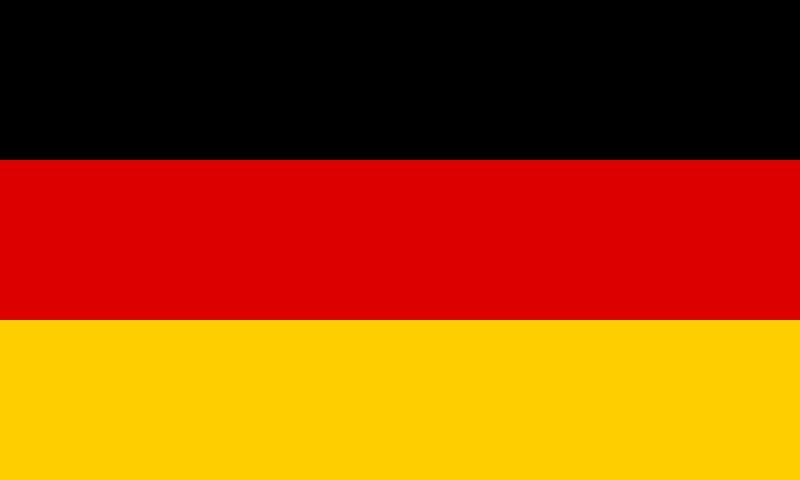National Symbols: Flag Details
Date First Used
1848–1867, 1919 (last adopted May 23, 1949)
Nickname(s)
“Bundesflagge” (“Federal Flag”)
Design Elements
A horizontal tricolor (1:1:1) of black-red-gold
Symbols: None
Colors: Black, red and gold are Germany's national colors, originally found on the coat of arms of the Holy Roman Empire of the German Nation (i.e., the First Reich); they are now considered representative of the unity and freedom of the German people.
Proportions: 3:5
Variations: The state flag and ensign/war flag are also the tricolor, with the German coat of arms charged in the center.
History
While the colors are taken from the medieval coat of arms of the Holy Roman Empire of the German Nation, the national flag of Germany has not always incorporated black, red and gold. After the Austro-Prussian War in 1866, the Prussian-dominated North German Confederation adopted a tricolor of black-white-red. This flag later became the flag of the German Empire, formed following the unification of Germany in 1871, and was used until 1918. Notoriously, black, white and red were reintroduced as the German national colors with the establishment of Nazi Germany in 1933.
The black-red-gold tricolor first appeared in the early 19th century and achieved prominence during the 1848 revolution (see Legends, Controversies, and Trivia below). The short-lived Frankfurt Parliament of 1848–50 proposed the tricolor as a flag for a united and democratic German state. In 1919, with the formation of the Weimar Republic after World War I, the tricolor was adopted as the national flag of Germany. Following Allied occupation after WWII, on May 23, 1949, the black-red-gold tricolor was adopted as the flag for the Federal Republic of Germany (West Germany). It was also designated as the flag for East Germany—in fact, the two flags were identical until 1959, when communist symbols were added to the East German flag. Since October 3, 1990, the country has been reunified under one national flag: the unadorned black-red-gold tricolor.
Proper Uses
Apart from the obligation to fly flags on general flag days, every national citizen is free to use the flags of the nation, of federal states, or of cities, as long as they are not service flags. Flags must be hoisted at daybreak and taken down at sunset. In special circumstances flags may be used after sunset as long as they are illuminated. The federal flag or federal service flag must never be used to adorn the podium or desk of a speaker. In this case the federal flag must be displayed either behind the podium or to its right. When a flag is longer presentable it must no longer be used
Legends, Controversies, and Trivia
During the Napoleonic Wars, the German struggle against the occupying French forces was symbolized by the colors of black, red and gold. This was largely attributed to the uniforms of the Lützow Free Corps, a volunteer unit of the Prussian Army. The uniforms for this unit were black with red facings and gold buttons. The color choice here was a pragmatic one, even though it was also a popularization of the black-red-gold colors used by the former Holy Roman Empire. Members of the corps were required to supply their own clothing and, in order to present a uniform appearance, it was easiest to dye all clothes black. Gold-colored buttons were widely available and pennons used by the lancers in the unit were red and black. At the time, the colors represented "Out of the darkness (black) of servitude through bloody (red) conflict to the (golden) light of freedom." As the members of this unit came from all over Germany, the Lützow Free Corps and their colors garnered considerable sympathy among the German people
From 1956 to 1964, West and East Germany attended the Winter and Summer Olympic Games as a single team, known as the Unified Team of Germany. After the East German national flag was changed in 1959, neither country accepted the flag of the other. As a compromise, a new flag was used from 1960 to 1968, featuring the black-red-gold tricolor defaced with white Olympic rings in the red stripe.
The color used in the German flag is officially designated as gold, not yellow. When the black-red-gold tricolor was adopted by the Weimar Republic as its flag, it was attacked by conservatives, monarchists and the far right, who referred to the colors with derogatory nicknames, such as Schwarz-Rot-Gelb (“black-red-yellow”), Schwarz-Rot-Senf (“black-red-mustard”) or even Schwarz-Rot-Scheiße (“black-red-shit”).When the Nazis came to power in 1933, the black-white-red colors of pre-1918 Imperial Germany were swiftly reintroduced and the Nazi propaganda machine continued to discredit the Schwarz-Rot-Gold , using the same pejorative terms earlier used by the monarchists. On November 16, 1959, the Federal Court of Justice (Bundesgerichtshof) stated that the usage of phrases like "black-red-yellow" had "through years of Nazi agitation attained the significance of a malicious slander against the democratic symbols of the state," and was now an offence. It is now also against the law to possess or display the Nazi swastika flag throughout Germany.
Copyright © 1993—2025 World Trade Press. All rights reserved.

 Germany
Germany 